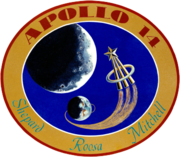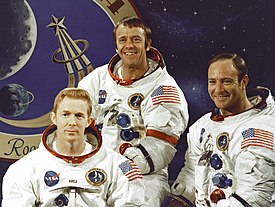
Back Apollo 14 Afrikaans أبولو 14 Arabic Apollon 14 Azerbaijani Апалон-14 Byelorussian Аполо 14 Bulgarian অ্যাপোলো ১৪ Bengali/Bangla Apollo 14 Breton Apollo 14 Catalan Apollo 14 Czech Apollo 14 Welsh
 Alan Shepard and the American flag on the Moon, Apollo 14, February 1971 (photo by Edgar Mitchell) | |
| Mission type | Crewed lunar landing (H) |
|---|---|
| Operator | NASA[1] |
| COSPAR ID | |
| SATCAT no. | |
| Mission duration | 9 days, 1 minute, 58 seconds |
| Spacecraft properties | |
| Spacecraft |
|
| Manufacturer | CSM: North American Rockwell LM: Grumman |
| Launch mass | 102,084 pounds (46,305 kg) |
| Landing mass | 11,481 pounds (5,208 kg) |
| Crew | |
| Crew size | 3 |
| Members | |
| Callsign |
|
| Start of mission | |
| Launch date | January 31, 1971, 21:03:02 UTC |
| Rocket | Saturn V SA-509 |
| Launch site | Kennedy LC-39A |
| End of mission | |
| Recovered by | USS New Orleans |
| Landing date | February 9, 1971, 21:05:00 UTC |
| Landing site | South Pacific Ocean 27°1′S 172°39′W / 27.017°S 172.650°W |
| Orbital parameters | |
| Reference system | Selenocentric |
| Periselene altitude | 16.9 kilometers (9.1 nmi) |
| Aposelene altitude | 108.9 kilometers (58.8 nmi) |
| Period | 120 minutes |
| Lunar orbiter | |
| Spacecraft component | Command and service module |
| Orbital insertion | February 4, 1971, 06:59:42 UTC |
| Orbital departure | February 7, 1971, 01:39:04 UTC |
| Orbits | 34 |
| Lunar lander | |
| Spacecraft component | Lunar Module |
| Landing date | February 5, 1971, 09:18:11 UTC |
| Return launch | February 6, 1971, 18:48:42 UTC |
| Landing site | Fra Mauro 3°38′43″S 17°28′17″W / 3.64530°S 17.47136°W |
| Sample mass | 42.80 kilograms (94.35 lb) |
| Surface EVAs | 2 |
| EVA duration |
|
| Docking with LM | |
| Docking date | February 1, 1971, 01:57:58 UTC |
| Undocking date | February 5, 1971, 04:50:43 UTC |
| Docking with LM ascent stage | |
| Docking date | February 6, 1971, 20:35:52 UTC |
| Undocking date | February 6, 1971, 22:48:00 UTC |

 Stuart Roosa, Alan Shepard, Edgar Mitchell | |
Apollo 14 (January 31 – February 9, 1971) was the eighth crewed mission in the United States Apollo program, the third to land on the Moon, and the first to land in the lunar highlands. It was the last of the "H missions", landings at specific sites of scientific interest on the Moon for two-day stays with two lunar extravehicular activities (EVAs or moonwalks).
The mission was originally scheduled for 1970, but was postponed because of the investigation following the failure of Apollo 13 to reach the Moon's surface, and the need for modifications to the spacecraft as a result. Commander Alan Shepard, Command Module Pilot Stuart Roosa, and Lunar Module Pilot Edgar Mitchell launched on their nine-day mission on Sunday, January 31, 1971, at 4:03:02 p.m. EST. En route to the lunar landing, the crew overcame malfunctions that might have resulted in a second consecutive aborted mission, and possibly, the premature end of the Apollo program.
Shepard and Mitchell made their lunar landing on February 5 in the Fra Mauro formation – originally the target of Apollo 13. During the two walks on the surface, they collected 94.35 pounds (42.80 kg) of Moon rocks and deployed several scientific experiments. To the dismay of some geologists, Shepard and Mitchell did not reach the rim of Cone crater as had been planned, though they came close. In Apollo 14's most famous event, Shepard hit two golf balls he had brought with him with a makeshift club.
While Shepard and Mitchell were on the surface, Roosa remained in lunar orbit aboard the Command and Service Module, performing scientific experiments and photographing the Moon, including the landing site of the future Apollo 16 mission. He took several hundred seeds on the mission, many of which were germinated on return, resulting in the so-called Moon trees, that were widely distributed in the following years. After liftoff from the lunar surface and a successful docking, the spacecraft was flown back to Earth where the three astronauts splashed down safely in the Pacific Ocean on February 9.
- ^ Orloff, Richard W. (September 2004) [First published 2000]. "Table of Contents". Apollo by the Numbers: A Statistical Reference. NASA History Series. Washington, D.C.: NASA. ISBN 0-16-050631-X. LCCN 00061677. NASA SP-2000-4029. Archived from the original on September 6, 2007. Retrieved July 17, 2013.
- ^ a b Orloff & Harland 2006, p. 396.
- ^ "Apollo 14 Command and Service Module (CSM)". NASA Space Science Data Coordinated Archive. Retrieved November 20, 2019.
- ^ "Apollo 14 Lunar Module /ALSEP". NASA Space Science Data Coordinated Archive. Retrieved November 20, 2019.